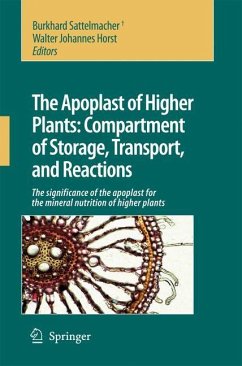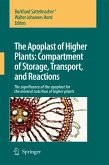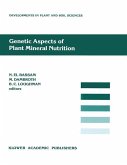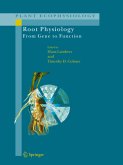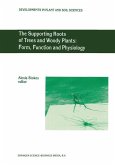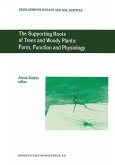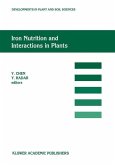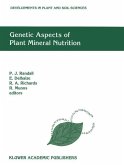The Apoplast of Higher Plants: Compartment of Storage, Transport and Reactions
The significance of the apoplast for the mineral nutrition of higher plants
Herausgegeben:Sattelmacher, Burkhard; Horst, Walter J.
The Apoplast of Higher Plants: Compartment of Storage, Transport and Reactions
The significance of the apoplast for the mineral nutrition of higher plants
Herausgegeben:Sattelmacher, Burkhard; Horst, Walter J.
- Broschiertes Buch
- Merkliste
- Auf die Merkliste
- Bewerten Bewerten
- Teilen
- Produkt teilen
- Produkterinnerung
- Produkterinnerung
The apoplast may be considered as "the internal physiological environment of plant bodies", that essentially maintains homeostasis.
The book summarizes the experimental work conducted during a trans-disciplinary research programme funded for six years by the German Research Foundation. In their contributions, the authors representing outstanding German scientists from such different disciplines as Physics, Biochemistry, Plant Nutrition, Botany, and Molecular Biology not only report original research but also review the state of knowledge in their particular research fields: nutrient…mehr
Andere Kunden interessierten sich auch für
![The Apoplast of Higher Plants: Compartment of Storage, Transport and Reactions The Apoplast of Higher Plants: Compartment of Storage, Transport and Reactions]() Burkhard Sattelmacher / Walter J. Horst (eds.)The Apoplast of Higher Plants: Compartment of Storage, Transport and Reactions161,99 €
Burkhard Sattelmacher / Walter J. Horst (eds.)The Apoplast of Higher Plants: Compartment of Storage, Transport and Reactions161,99 €![Genetic Aspects of Plant Mineral Nutrition Genetic Aspects of Plant Mineral Nutrition]() Nasir El BassamGenetic Aspects of Plant Mineral Nutrition249,99 €
Nasir El BassamGenetic Aspects of Plant Mineral Nutrition249,99 €![Root Physiology: from Gene to Function Root Physiology: from Gene to Function]() Root Physiology: from Gene to Function121,99 €
Root Physiology: from Gene to Function121,99 €![The Supporting Roots of Trees and Woody Plants: Form, Function and Physiology The Supporting Roots of Trees and Woody Plants: Form, Function and Physiology]() StokesThe Supporting Roots of Trees and Woody Plants: Form, Function and Physiology168,99 €
StokesThe Supporting Roots of Trees and Woody Plants: Form, Function and Physiology168,99 €![The Supporting Roots of Trees and Woody Plants: Form, Function and Physiology The Supporting Roots of Trees and Woody Plants: Form, Function and Physiology]() The Supporting Roots of Trees and Woody Plants: Form, Function and Physiology161,99 €
The Supporting Roots of Trees and Woody Plants: Form, Function and Physiology161,99 €![Iron Nutrition and Interactions in Plants Iron Nutrition and Interactions in Plants]() Iron Nutrition and Interactions in Plants249,99 €
Iron Nutrition and Interactions in Plants249,99 €![Genetic Aspects of Plant Mineral Nutrition Genetic Aspects of Plant Mineral Nutrition]() Genetic Aspects of Plant Mineral Nutrition42,99 €
Genetic Aspects of Plant Mineral Nutrition42,99 €-
-
-
The apoplast may be considered as "the internal physiological environment of plant bodies", that essentially maintains homeostasis.
The book summarizes the experimental work conducted during a trans-disciplinary research programme funded for six years by the German Research Foundation. In their contributions, the authors representing outstanding German scientists from such different disciplines as Physics, Biochemistry, Plant Nutrition, Botany, and Molecular Biology not only report original research but also review the state of knowledge in their particular research fields: nutrient acquisition, short and long distance (xylem) transport, tolerance of nutrient deficiencies and mineral toxicities, and the role of micro-organisms colonizing the apoplast.
Introductory remarks are written to each of the chapters by internationally highly recognized scientists in their research areas.
The book summarizes the experimental work conducted during a trans-disciplinary research programme funded for six years by the German Research Foundation. In their contributions, the authors representing outstanding German scientists from such different disciplines as Physics, Biochemistry, Plant Nutrition, Botany, and Molecular Biology not only report original research but also review the state of knowledge in their particular research fields: nutrient acquisition, short and long distance (xylem) transport, tolerance of nutrient deficiencies and mineral toxicities, and the role of micro-organisms colonizing the apoplast.
Introductory remarks are written to each of the chapters by internationally highly recognized scientists in their research areas.
Produktdetails
- Produktdetails
- Verlag: Springer / Springer Netherlands
- Artikelnr. des Verlages: 978-90-481-7454-6
- Softcover reprint of hardcover 1st edition 2007
- Seitenzahl: 472
- Erscheinungstermin: 10. November 2010
- Englisch
- Abmessung: 235mm x 155mm x 26mm
- Gewicht: 710g
- ISBN-13: 9789048174546
- ISBN-10: 9048174546
- Artikelnr.: 32107723
- Herstellerkennzeichnung Die Herstellerinformationen sind derzeit nicht verfügbar.
- Verlag: Springer / Springer Netherlands
- Artikelnr. des Verlages: 978-90-481-7454-6
- Softcover reprint of hardcover 1st edition 2007
- Seitenzahl: 472
- Erscheinungstermin: 10. November 2010
- Englisch
- Abmessung: 235mm x 155mm x 26mm
- Gewicht: 710g
- ISBN-13: 9789048174546
- ISBN-10: 9048174546
- Artikelnr.: 32107723
- Herstellerkennzeichnung Die Herstellerinformationen sind derzeit nicht verfügbar.
Burkhard Sattelmacher was an internationally highly estimated scientist in the area of plant mineral nutrition. He contributed substantially to the scientific excellence of Plant Nutrition especially through his engagement within the German Research foundation particularly through the initiation and contribution to coordinated research programmes and as a member of the International Council for Plant Nutrition. He was a stimulating teacher, mentor, and colleague. He found research in plant nutrition fascinating, and was able to transmit that fascination to those around him. He died in November 2005 at the age of 58 after many months of courageous fighting against his disease. Born in Kiel he studied Botany at the Technical University of Berlin. He got his PhD in Plant Nutrition at the same University under the guidance of Horst Marschner. Deeply concerned about poverty alleviation through plant-production research he continued his work on the physiology of potato for 4 years as a post doc at the International Potato Center (CIP), Lima, Peru. This and follow-up research in Hohenheim represented the basis for his habilitation at the University of Hohenheim in 1986. In 1985 he accepted the call as professor for Plant Nutrition in Kiel. Since 1992 he was head and chairholder of Plant Nutrition at the Institute of Plant Nutrition and Soil Science, Faculty of Agricultural and Nutritional Sciences, University of Kiel. In the centre of the scientific interest of Burkhard Sattelmacher was the physiology of crops. He was convinced that its basic understanding is a prerequisite for solving practical problems related to crop management. In the early nineties Burkhard Sattelmacher developed a research area on nutrient fluxes in agricultural land-use systems comparing conventional and "biological" plant-production systems. Over 9 years he participated in a German Research Foundation (DFG)-funded Special Research Project with research projects on root turn-over, N uptakeparticularly from manure, ammonia and dinitrogen-oxide emission in a winter rape-seed winter-barley rotation. He extended his interest to the nutrient budgets of natural ecosystems in the ecosystem research programme Bornhöveder Seenkette. Among the research projects he initiated during the last years were particularly two to which he devoted his full force until the last days of his life: the DFG Special Research Programme 'The apoplast of higher plants: compartment of storage, transport, and reactions' and the DFG Research Group 'Matter fluxes in grasslands of Inner Mongolia as influenced by stocking rate'. Burkhard Sattelmacher always maintained an interest in new developments in agronomy, botany, and soil science. He especially enjoyed discussing ideas with colleagues and students. He was highly estimated as a referee for scientific journals, as well as for funding agencies not only because of his wide knowledge and experience, but because his interest was in the progress of science, without personal bias. We have lost in Burkhard Sattelmacher an extraordinary person, teacher, scientist, and colleague. We will miss his stimulating contributions to scientific progress. The co-editor and the authors dedicate this book summarising the main achievement of the special research programme 'Apoplast' which he initiated and of which he was the speaker. Unfortunately, he did not have the pleasure to finish this book himself. Walter Horst
Cell wall-ion interactions: Significance for nutrition of plants and their stress tolerance.- Cell Wall-Ion Interactions.- Boron in the Apoplast of Higher Plants.- Silicon in Plant Nutrition.- Significance of the Root Apoplast for Aluminium Toxicity and Resistance of Maize.- Significance of Polyamines for Pectin-Methylesterase Activity and the ion Dynamics in the Apoplast.- The root apoplast - implication for ion acquisition and Short-distance transport.- The apoplast: A kinetic perspective.- The apoplast of ectomycorrhizal roots - site of nutrient uptake and nutrient exchange between the symbiotic partners.- Chemical compositon of apoplastic transport barriers in roots.- Apoplastic water transport in roots.- Ion uptake from and loading into the apoplast: Characterization of channel properties and relevance for the nutrition of plants.- Long Distance Transport in Plants: Towards Analyses of Regulatory Interactions Between Membrane Transport Systems and Cell Wall Ionic Atmosphere in Vascular Tissues.- The Role of Potassium in Wood Formation of Poplar.- Transport Characteristics of Ion Channels as Influenced by Apoplastic Properties.- Ion Uptake from the Xylem into the Symplasm of the Maize Leaf.- Loading of Ions into the Xylem of the Root.- The significance of the apoplast as a compartment for long-distance transport.- New Tools to Explore the Apoplast.- On-Line Measurements of Ion Relations in the Xylem Sap of Intact Plants.- Dynamic and Nutrient Fluxes in the Xylem.- Relationship Between Apoplastic Nutrient Concentrations and the Long-Distance Transport of Nutrients in the Ricinus communis L. Seedling.- Long-Distance Water Transport Under Controlled Transpirational Conditions: Minimal-Invasive Investigations by Means of Pressure Probes and NMR Imaging.- Changes inComposition of the Xylem Sap as well as in Ion Fluxes in Populus Tremula X Alba L. Xylem In Dependence on Exogenous Factors.- Ion relations in the apoplast of leaves.- Ion Dynamics in the Apoplast of Leaf Cells.- Probing Apoplastic Ion Relations in Vicia Faba as Influenced by Nutrition and Gas Exchange.- The Role of the Leaf Apoplast in Manganese Toxicity and Tolerance in Cowpea (Vigna Unguiculata L. Walp).- Interaction between Phloem transport and Apoplastic Solute Concentrations.- Investigations of the mechanisms of long-distance transport and ion distribution in the leaf apoplast of vicia faba l.- The dynamics of iron in the leaf apoplast.- Self-Reporting Arabidopsis Thaliana Expressing pH- and [CA2+] - Indicators Unveil Apoplastic Ion Dynamics.- The apoplast compartment for plant-microbe interactions.- Constraints For Endophytic Bacteria.- The Apoplast of Norway Spruce (Picea Abies) Needles as Habitat and Reaction Compartment for Autotrophic Nitrifiers.- The Rice Apoplast as a Habitat for Endophytic N2-Fixing Bacteria.- The Apoplast of Indeterminate Legume Nodules: Compartment for Transport of Amino Acids, Amides and Sugars?.
Cell wall-ion interactions: Significance for nutrition of plants and their stress tolerance.- Cell Wall-Ion Interactions.- Boron in the Apoplast of Higher Plants.- Silicon in Plant Nutrition.- Significance of the Root Apoplast for Aluminium Toxicity and Resistance of Maize.- Significance of Polyamines for Pectin-Methylesterase Activity and the ion Dynamics in the Apoplast.- The root apoplast - implication for ion acquisition and Short-distance transport.- The apoplast: A kinetic perspective.- The apoplast of ectomycorrhizal roots - site of nutrient uptake and nutrient exchange between the symbiotic partners.- Chemical compositon of apoplastic transport barriers in roots.- Apoplastic water transport in roots.- Ion uptake from and loading into the apoplast: Characterization of channel properties and relevance for the nutrition of plants.- Long Distance Transport in Plants: Towards Analyses of Regulatory Interactions Between Membrane Transport Systems and Cell Wall Ionic Atmosphere in Vascular Tissues.- The Role of Potassium in Wood Formation of Poplar.- Transport Characteristics of Ion Channels as Influenced by Apoplastic Properties.- Ion Uptake from the Xylem into the Symplasm of the Maize Leaf.- Loading of Ions into the Xylem of the Root.- The significance of the apoplast as a compartment for long-distance transport.- New Tools to Explore the Apoplast.- On-Line Measurements of Ion Relations in the Xylem Sap of Intact Plants.- Dynamic and Nutrient Fluxes in the Xylem.- Relationship Between Apoplastic Nutrient Concentrations and the Long-Distance Transport of Nutrients in the Ricinus communis L. Seedling.- Long-Distance Water Transport Under Controlled Transpirational Conditions: Minimal-Invasive Investigations by Means of Pressure Probes and NMR Imaging.- Changes inComposition of the Xylem Sap as well as in Ion Fluxes in Populus Tremula X Alba L. Xylem In Dependence on Exogenous Factors.- Ion relations in the apoplast of leaves.- Ion Dynamics in the Apoplast of Leaf Cells.- Probing Apoplastic Ion Relations in Vicia Faba as Influenced by Nutrition and Gas Exchange.- The Role of the Leaf Apoplast in Manganese Toxicity and Tolerance in Cowpea (Vigna Unguiculata L. Walp).- Interaction between Phloem transport and Apoplastic Solute Concentrations.- Investigations of the mechanisms of long-distance transport and ion distribution in the leaf apoplast of vicia faba l.- The dynamics of iron in the leaf apoplast.- Self-Reporting Arabidopsis Thaliana Expressing pH- and [CA2+] - Indicators Unveil Apoplastic Ion Dynamics.- The apoplast compartment for plant-microbe interactions.- Constraints For Endophytic Bacteria.- The Apoplast of Norway Spruce (Picea Abies) Needles as Habitat and Reaction Compartment for Autotrophic Nitrifiers.- The Rice Apoplast as a Habitat for Endophytic N2-Fixing Bacteria.- The Apoplast of Indeterminate Legume Nodules: Compartment for Transport of Amino Acids, Amides and Sugars?.

